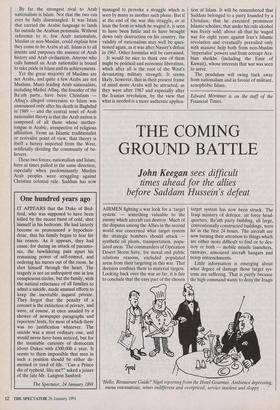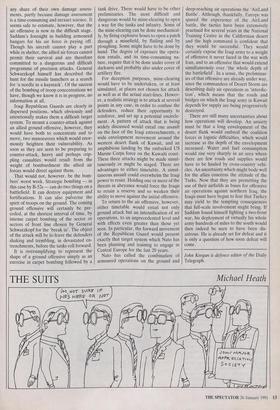THE COMING GROUND BATTLE
John Keegan sees difficult times ahead for the allies before Saddam Hussein's defeat
AIRMEN fighting a war look for a 'target system' — something valuable to the enemy which aircraft can destroy. Much of the disputes among the Allies in the second world war concerned what target system the strategic bombers should attack synthetic oil plants, transportation, popu- lated areas. The commanders of Operation Desert Storm have, for moral and public relations reasons, excluded populated areas from their targeting in this war. That decision confines them to material targets. Looking back over the war so far, it is fair to conclude that the easy part of the chosen target system has now been struck. The Iraqi ministry of defence, air force head- quarters, Ba'ath party building, all large, conventionally constructed buildings, were hit in the first 24 hours. The aircraft are now turning their attention to things which are either more difficult to find or to des- troy or both — mobile missile launchers, runways, armoured aircraft hangars and troop entrenchments.
Little information is emerging about what degree of damage those target sys- tems are suffering. That is partly because the high command wants to deny the Iraqis `Hello, Restaurant Guide? Nigel reporting from the Hotel Gourmet. Ambience depressing, menu ostentatious, wines indifferent and overpriced, service insolent and sloppy . . any share of their own damage assess- ments, partly because damage assessment is a time-consuming and inexact science. It seems safe to estimate, however, that the air offensive is now in the difficult stage. Saddam's foresight in building armoured hangars for his air force is paying off. Though his aircraft cannot play a part while in shelter, the allied air forces cannot permit their survival and are therefore committed to a dangerous and difficult programme of precision attacks. General Schwarzkopf himself has described the hunt for the missile launchers as a search for 'a needle in a haystack'. Of the success of the bombing of troop concentrations we have, though we know it is in progress, no information at all.
Iraqi Republican Guards are clearly in dispersed positions, which obviously and intentionally makes them a difficult target system. To mount a counter-attack against an allied ground offensive, however, they would have both to concentrate and to move, two manoeuvres which would enor- mously heighten their vulnerability. As soon as they are seen to be preparing to counter-attack, heavy and perhaps crip- pling casualties would result from the weight of bombardment the allied air forces would direct against them.
That would not, however, be the bom- bers' worst work. Strategic bombing — in this case by B-52s — can do two things on a battlefield. It can destroy equipment and fortifications. It can also pulverise the spirit of troops on the ground. The coming ground offensive will certainly be pre- ceded, at the shortest interval of time, by intense carpet bombing of the sector or sectors of front line chosen by General Schwarzkopf for the 'break in'. The object of the attack will be to leave the defenders shaking and trembling, in devastated en- trenchments, before the tanks roll forward.
It is oversimplifying to represent the shape of a ground offensive simply as an exercise in carpet bombing followed by a tank drive. There would have to be other preliminaries. The most difficult and dangerous would be mine-clearing to open a way for the tanks and infantry. Some of the mine-clearing can be done mechanical- ly, by firing explosive hoses to open a patch through a minefield, by flailing and by ploughing. Some might have to be done by hand. The degree of exposure the opera- tion entails, and its time-consuming na- ture, require that it be done under cover of darkness and probably also under cover of artillery fire.
For deception purposes, mine-clearing would have to be undertaken, or at least simulated, at places not chosen for attack as well as at the actual start-lines. Howev- er, a realistic strategy is to attack at several points in any case, in order to confuse the defenders, reduce their opportunity to reinforce, and set up a potential encircle- ment. A pattern of attack that is being widely discussed would entail one assault on the face of the Iraqi entrenchments, a wide envelopment movement around the western desert flank of Kuwait, and an amphibious landing by the embarked US Marine Corps force on the Kuwaiti coast. These three attacks might be made simul- taneously or might be staged. There are advantages to either timetable. A simul- taneous assault could overwhelm the Iraqi power to resist. Holding one or more of the threats in abeyance would force the Iraqis to retain a reserve and so weaken their ability to move against the initial offensive.
To return to the air offensive, however, either timetable would entail not only ground attack but an intensification of air operations, to an unprecedented level and with effects even greater than those yet seen. In particular, the forward movement of the Republican Guard would present exactly that target system which Nato has been planning and training to engage in Central Europe for the last 20 years.
Nato has called the combination of armoured operations on the ground and deep-reaching air operations the 'AirLand Battle'. Although, thankfully, Europe was spared the experience of the AirLand battle, the tactics have been extensively practised for several years in the National Training Centre in the Californian desert and the high command is confident that they would be successful. They would certainly expose the Iraqi army to a weight of offensive it never faced in the war with Iran, and to an offensive that would extend simultaneously over 'the whole depth of the battlefield'. In a sense, the preliminar- ies of that offensive are already under way, since the commanders of Desert Storm are describing daily air operations as 'interdic- tion', which means that the roads and bridges on which the Iraqi army in Kuwait depends for supply are being progressively destroyed.
There are still many uncertainties about how operations will develop. An anxiety must be that a long envelopment of the desert flank would embroil the coalition forces in logistic difficulties, which would increase as the depth of the envelopment increased. Water and fuel consumption would rise very sharply in an area where there are few roads and supplies would have to be hauled by cross-country vehi- cles. An uncertainty which might bode well for the allies concerns the attitude of the Turks. Now that they are permitting the use of their airfields as bases for offensive air operations against northern Iraq, the Iraqis must have begun to fear that Turkey may yield to the tempting consequences that full-scale involvement might bring. If Saddam found himself fighting a two-front war, his deployment of virtually his whole army hundreds of miles to the south would then indeed be seen to have been dis- astrous. He is already set for defeat and it is only a question of how soon defeat will come.
John Keegan is defence editor of the Daily Telegraph.



























































 Previous page
Previous page